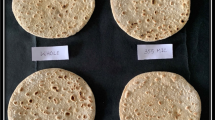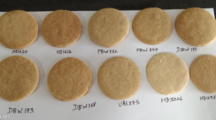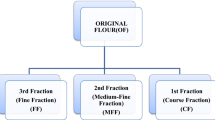Abstract
Two wheat varieties ‘C 306’ and ‘WH 542’ were milled to obtain flour fractions of different particle sizes. Various physicochemical parameters such as wet and dry gluten, falling number, solvent retention capacity (SRC), alkaline water retention capacity (AWRC) and damaged starch content of the flour fractions were analyzed. The damaged starch values ranged from 5.14% to 14.79% for different flour fractions and increased significantly with decrease in particle size. AWRC and SRC of the flour fractions also increased with decrease in particle size. AWRC(r = 0.659) showed positive correlation and cookie spread ratio (r = −0.826) was strongly negatively correlated with the damaged starch levels. Hardness of the cookies in term of compression force showed increasing trend as damaged starch of the flour fractions increased. Spread ratio of the cookies ranged from 6.72 to 10.12. Wheat flour of particle size greater than 150 μm produced cookies with best quality.


Similar content being viewed by others

References
Abboud A, Hoseney RC, Rubenthaler G (1985) Effect of fat and sugar in sugar snap cookies and evaluation of test measure cookie flour quality. Cereal Chem 62:124–129
Alsberg CL, Griffing EP (1925) Effect of fine grinding upon flour. Cereal Chem 2:325–344
American Association of Cereal Chemists (2000) Approved methods of the AACC. American Association of Cereal Chemists, St. Paul
Das A, Raychaudhuri U, Chakraborty R (2011) Cereal based functional food of Indian subcontinent: a review. J Food Sci Technol. doi:10.1007/s13197-011-0474-1
Doescher L, Hoseney RC (1985) Effect of sugar type and flour moisture on surface cracking of sugar-snap cookies. Cereal Chem 62:263–266
Donelson JR, Gaines CS (1998) Starch–water relationships in the sugar-snap cookie dough system. Cereal Chem 75:660–664
Faridi H, Gaines C, Finney P (1994) Soft wheat quality in production of cookies and crackers. In: Bushuk W, Rasper VF (eds) Wheat production, properties and quality. Chapman and Hall, Bishopbriggs, pp 154–168
Farrand EA (1972) The influence of particle size and starch damage on the characteristics of bread flours. Bakers Digest 46:22–26
Gaines CS, Donelson JR, Finney PL (1988) Effects of damaged starch, chlorine gas, flour particle size, and dough holding time and temperature on cookie dough handling properties and cookie size. Cereal Chem 65:384–389
Gupta RK, Mohan D, Ram S & Mishra B (2006) Wheat quality, all India coordinated wheat and barley improvement project. pp. 133–156. Directorate of Wheat Research, Karnal, India.
Guttieri MJ, Bowen D, Gannon D, O’Brien K, Souza E (2001) Solvent retention capacities of irrigated soft white spring wheat flours. Crop Sci 41:1054–1061
Haynes LC, Bettge AD, Slade L (2009) Soft wheat and flour products methods review: solvent retention capacity equation correction. Cereal Foods World 54:174–175
Khatkar BS, Schofield D (1997) Molecular and physicochemical basis of breadmaking properties of wheat gluten proteins: a critical appraisal. J Food Sci Technol 34:86–102
Kissel L, Lorenz K (1976) Performance of triticale flours in test for soft wheat quality. Cereal Chem 52:638–649
Leon AE, Rubiolo OJ, Anon MC (1996) Use of triticale flours in cookies: quality factors. Cereal Chem 73:779–784
Okkada K, Negishi Y, Nagao S (1986) Studies on heavily ground flour using roller mills I. Alternation in flour characteristics through overgrinding. Cereal Chem 63:187–193
Shekara P, Kumar VP, Hosamane GG (2011) Gravity flow operated small electricity generator retrofit kit to flour mill industry. J Food Sci Technol. doi:10.1007/s13197-011-0406-0
Simmonds DH (1974) Chemical basis of hardness and vitreosity in the wheat kernel. Bakers Digest 48:16–29
Singh M, Khatkar BS (2005) Structural and functional properties of wheat storage proteins: a review. J Food Sci Technol 42:455–471
Slade L, Levine H (1994) Structure and function relationships of cookie and cracker ingredients. In: Faridi H (ed) The science of cookie and cracker production. Chapman & Hall, AVI, New York, pp 23–141
Yamamoto H, Worthington ST, Hou G, Ng P (1996) Rheological properties and baking qualities of selected soft wheats in the United States. Cereal Chem 73:215–221
Yamazaki WT (1959) Flour granularity and cookie quality II. Effects of changes in granularity on cookie characteristics. Cereal Chem 36:52–59
Author information
Authors and Affiliations
Corresponding author
Rights and permissions
About this article
Cite this article
Barak, S., Mudgil, D. & Khatkar, B.S. Effect of flour particle size and damaged starch on the quality of cookies. J Food Sci Technol 51, 1342–1348 (2014). https://doi.org/10.1007/s13197-012-0627-x
Revised:
Accepted:
Published:
Issue Date:
DOI: https://doi.org/10.1007/s13197-012-0627-x



